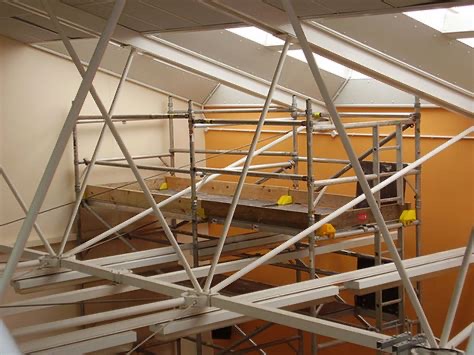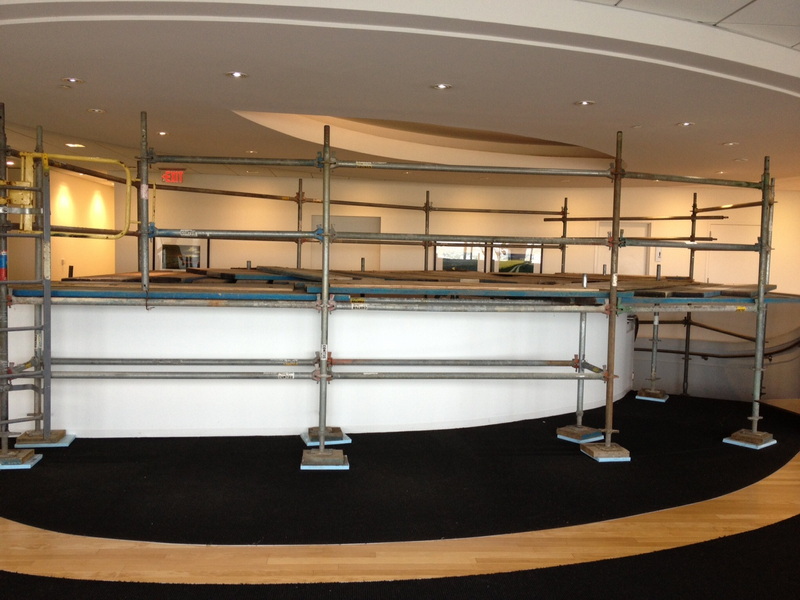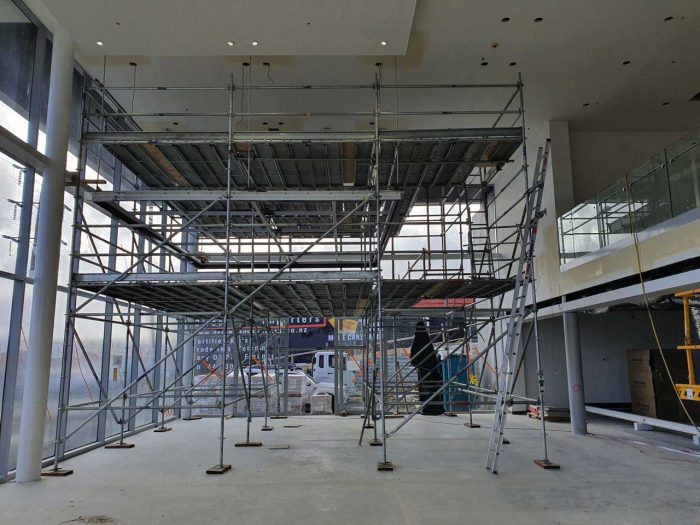Content Menu
● Introduction to Interior Scaffolding Systems
● Key Features of Interior Scaffolding Systems
● Cost Benefits of Using an Interior Scaffolding System
>> 1. Increased Productivity
>> 2. Reduced Labor Costs
>> 3. Improved Safety and Reduced Accident Costs
>> 4. Versatility and Adaptability
>> 5. Reduced Material Handling Costs
>> 6. Long-Term Cost Savings
● Types of Interior Scaffolding Systems and Their Cost Implications
>> 1. Supported Scaffolding
>> 2. Adjustable Systems
>> 3. Modular Scaffolding
>> 4. Rolling Scaffolds
● Maximizing Cost Benefits: Best Practices
● Conclusion
● FAQ
>> 1. What is an interior scaffolding system?
>> 2. How does interior scaffolding increase productivity?
>> 3. What are the safety benefits of using interior scaffolding?
>> 4. What types of projects are suitable for interior scaffolding?
>> 5. How can contractors maximize the cost benefits of using interior scaffolding?
● Citations:
When undertaking any interior construction, renovation, or maintenance project, one of the critical decisions involves selecting the right access solution. While ladders and other makeshift arrangements might seem appealing for their perceived low cost, an interior scaffolding system often presents a more cost-effective, safer, and efficient alternative in the long run. This article delves into the numerous cost benefits of using an interior scaffolding system for your project, examining how it can save you time, reduce labor expenses, minimize accidents, and improve overall productivity.

Introduction to Interior Scaffolding Systems
An interior scaffolding system is a temporary structure erected inside a building to provide a safe and stable platform for workers to perform tasks at height. Unlike exterior scaffolding, which is designed for outdoor use and often built on a larger scale, interior scaffolding is typically lighter, more compact, and easier to maneuver within confined spaces. These systems are essential for a wide range of projects, including painting, electrical work, HVAC installation, ceiling repairs, and decorative finishes.
Key Features of Interior Scaffolding Systems
- Modular Design: Interior scaffolding systems are typically modular, allowing for easy assembly and disassembly.[1]. This modularity enables contractors to adapt the scaffolding to different project requirements and navigate tight spaces.[1].
- Lightweight Materials: Constructed from aluminum or high-grade steel, interior scaffolding is lightweight yet sturdy, making it easy to transport and assemble.[1][7].
- Adjustable Height: Most interior scaffolding systems offer adjustable height settings, providing flexibility for various ceiling heights and project needs.[1].
- Safety Features: Modern interior scaffolding systems come equipped with safety features such as guardrails, non-slip surfaces, and secure locking mechanisms.[5].
- Mobility: Many interior scaffolding systems are mobile, featuring wheels or casters that allow for easy movement around the work area.[3].
Cost Benefits of Using an Interior Scaffolding System
The initial cost of acquiring or renting an interior scaffolding system may seem higher than alternative access solutions. However, when considering the long-term benefits, it often proves to be a more cost-effective choice.
1. Increased Productivity
An interior scaffolding system provides a stable and comfortable working platform, allowing workers to perform tasks more efficiently.[5]. With a secure footing and ample space to move around, workers can focus on their tasks without worrying about balance or stability. This leads to increased productivity and faster project completion times.[5].
The efficiency of modern scaffolding means that workers can spend more time on productive tasks rather than struggling with complex assembly or dealing with safety concerns.[5]
2. Reduced Labor Costs
The ease of assembly and disassembly of interior scaffolding systems can significantly reduce labor costs.[2]. Modern systems are designed for quick setup, minimizing the time required for scaffolding erection and dismantling.[2]. Additionally, the stability and accessibility provided by the scaffolding can reduce the number of workers needed for certain tasks, further lowering labor expenses.
3. Improved Safety and Reduced Accident Costs
Safety is a paramount concern in any construction project, and interior scaffolding systems play a crucial role in preventing accidents and injuries.[5]. These systems are designed to meet or exceed safety standards, providing workers with a secure working environment.[6]. By reducing the risk of falls and other accidents, interior scaffolding can help contractors avoid costly medical expenses, workers' compensation claims, and project delays.[5].
4. Versatility and Adaptability
Interior scaffolding systems are versatile and adaptable, capable of accommodating various project requirements and confined spaces.[1]. Modular systems can be configured to fit different room sizes and shapes, allowing workers to access even the most difficult-to-reach areas.[1]. This versatility eliminates the need for multiple access solutions, saving contractors time and money.
5. Reduced Material Handling Costs
Professional scaffolding services optimize loading capacities and strategically place access points, facilitating the smooth flow of materials and tools[1]. This makes moving materials and tools to where they're needed faster, boosting productivity and avoiding delays[1].
6. Long-Term Cost Savings
Investing in high-quality aluminum scaffolding pays off over time[2]. Aluminum's rust resistance means less money spent on maintenance compared to steel[2]. Lightweight aluminum also reduces transport and handling expenses[2].

Types of Interior Scaffolding Systems and Their Cost Implications
The choice of interior scaffolding system can also impact project costs. Different types of systems offer varying levels of efficiency, safety, and adaptability.
1. Supported Scaffolding
Supported scaffolding is a cost-effective option for interior projects, providing a stable and reliable platform for workers[1]. These systems are easy to assemble and can be quickly adjusted to different heights.
2. Adjustable Systems
Adjustable systems offer faster setup times and greater flexibility compared to supported scaffolding[1]. They can be easily adapted to different room sizes and shapes, making them ideal for complex interior projects.
3. Modular Scaffolding
Modular scaffolding is highly versatile and adaptable, making it suitable for a wide range of interior projects[1]. These systems use prefabricated modules that can be easily assembled and reconfigured to meet specific needs.
4. Rolling Scaffolds
Rolling scaffolds are mobile platforms that can be easily moved around the work area[3]. They are ideal for tasks that require frequent relocation, such as painting or electrical work.
Maximizing Cost Benefits: Best Practices
To maximize the cost benefits of using an interior scaffolding system, contractors should follow these best practices:
- Proper Planning: Carefully plan the scaffolding setup to ensure it meets the specific requirements of the project.
- Component Selection: Choose the right components for the job, considering factors such as load capacity, height, and mobility.
- Thorough Training: Provide comprehensive training to all workers on the assembly, use, and safety procedures of the scaffolding system.
- Regular Inspections: Conduct regular inspections of the scaffolding to ensure all components are in good working condition and that safety protocols are being followed.
- Maintenance: Maintain the scaffolding system properly, replacing any damaged or worn components promptly.
- Compliance: Ensure the scaffolding system complies with all relevant safety standards and regulations.
- Coordination: Coordinate scaffolding activities with other construction tasks to minimize disruptions and maximize efficiency.
Conclusion
Investing in an interior scaffolding system offers numerous cost benefits for construction, renovation, and maintenance projects. From increased productivity and reduced labor costs to improved safety and versatility, interior scaffolding can significantly enhance the efficiency and profitability of your projects. By carefully planning your scaffolding setup, choosing the right system for your needs, and adhering to best practices, you can maximize the cost savings and ensure a safe and successful outcome.

FAQ
1. What is an interior scaffolding system?
An interior scaffolding system is a temporary structure erected inside a building to provide a safe and stable platform for workers to perform tasks at height.[1].
2. How does interior scaffolding increase productivity?
By providing a stable and comfortable working platform, interior scaffolding allows workers to focus on their tasks without worrying about balance or stability, leading to increased productivity.[5].
3. What are the safety benefits of using interior scaffolding?
Interior scaffolding reduces the risk of falls and other accidents, helping contractors avoid costly medical expenses, workers' compensation claims, and project delays[5].
4. What types of projects are suitable for interior scaffolding?
Interior scaffolding is suitable for a wide range of projects, including painting, electrical work, HVAC installation, ceiling repairs, and decorative finishes[1].
5. How can contractors maximize the cost benefits of using interior scaffolding?
Contractors can maximize cost benefits by carefully planning their scaffolding setup, choosing the right system for their needs, and adhering to best practices such as providing thorough training and conducting regular inspections.
Citations:
[1] https://scaffoldtype.com/scaffold-interior/
[2] https://www.k2scaffold.com/post/how-k2-scaffolding-can-save-your-time-and-money-on-your-next-project
[3] https://scaffoldtype.com/indoor-scaffolding/
[4] https://scaffoldtype.com/scaffolding/
[5] https://www.scaffoldusa.com/modern-scaffolding/
[6] https://www.scaffoldingsolutions.com/articles/why-system-scaffolding-is-the-safest-scaffolding/
[7] https://layherna.com/l/benefits-of-using-interior-scaffolding/
[8] https://www.linkedin.com/pulse/i-didnt-know-could-reduce-my-scaffolding-cost-robert-bokros






















